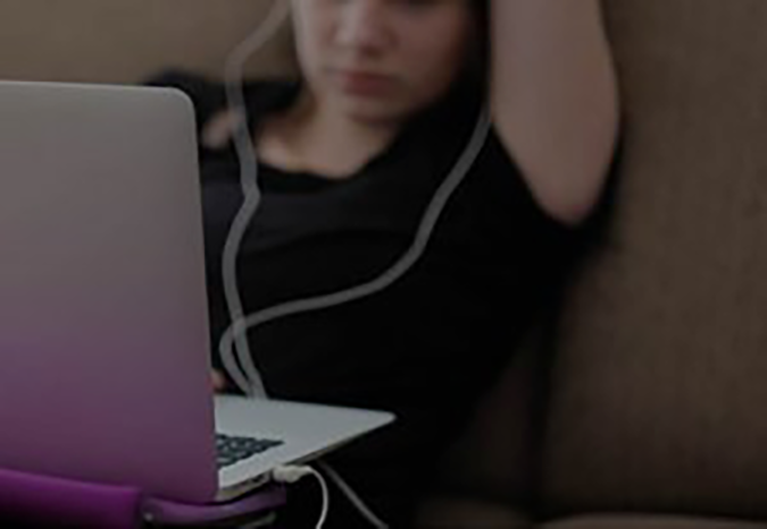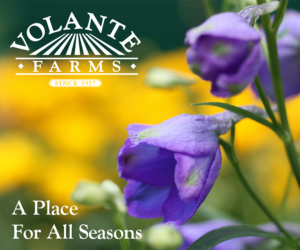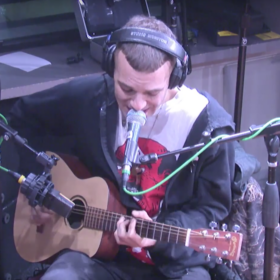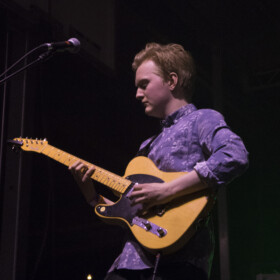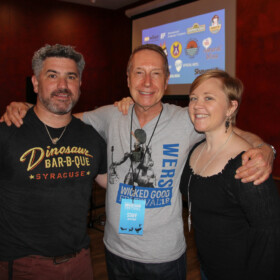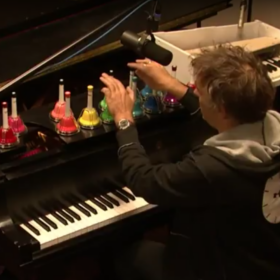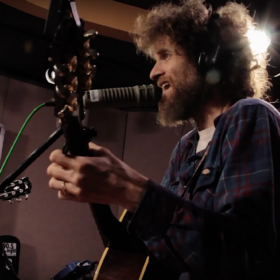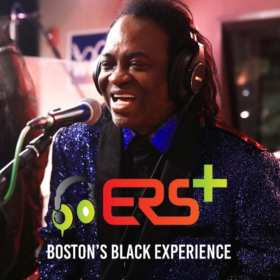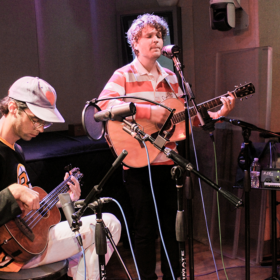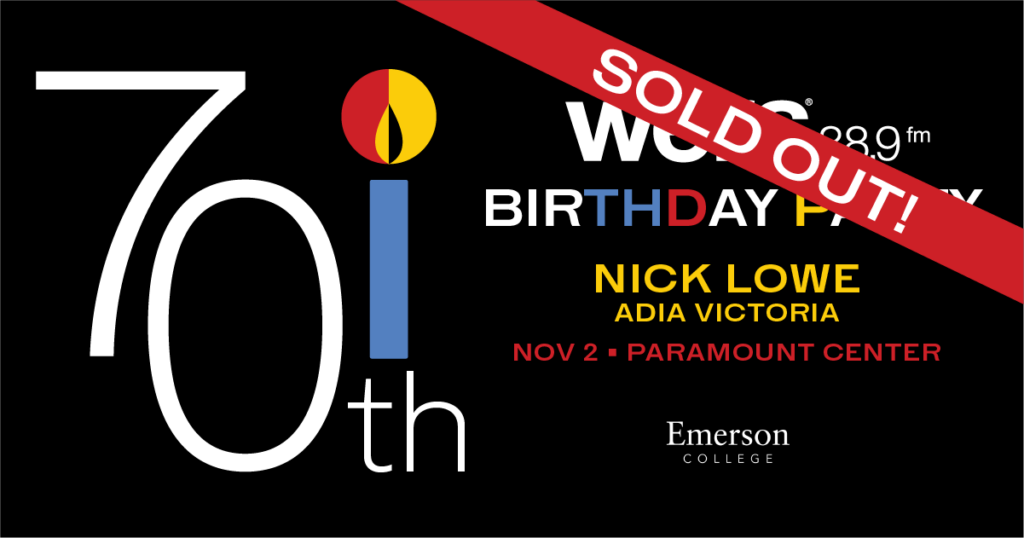By: Phillip Jones & Nina Ortiz
Big Data, initially comprised of Daniel Armbruster of Joywave and producer Alan Wilkis, hit the airwaves in 2013 with their hit “Dangerous”,an irresistible anthem to the perils of the internet. Now Wilkis flies solo and has been hitting the road with a touring band, covering several major festivals this past summer, and generating buzz the whole way. When we heard they were coming to the Cambridge on March 25th, we couldn’t pass up a shot at an interview. Big Data describe themselves as paranoid rock from the internet, but that doesn’t mean he’s not personable. We met Mr. Big Data in a tea shop outside The Sinclair where over three hundred people had gathered to sing along to “Dangerous”. We expected to meet a character not unlike the paranoid victim of the digital age portrayed in the song. We were instead greeted by a man with all the affability of your favourite professor, energetic, and fit from several months romping through physically strenuous performances. Before he took the stage with his five piece band, we spoke with Mr. Wilkis about his new record 2.0, the internet, and what’s next.
WERS: You’ve been making music for a long time, both as Alan Wilkis, and as PRINTS. What told you that this music needed to be a separate project, and that it was time to make Big Data?
Alan Wilkis: It kinda started with a gut feeling really. It kinda grew out of the PRINTS thing. I was basically gonna make one song with Dan from Joywave, and there was something sorta special about the way we worked right out of the gate. That spark said, well maybe I should make this a project. Then once I had the name, thats when the conceptual stuff started to grow.
W: So the conceptual stuff. Lyrically its all centered around paranoia in the digital age. How does the music under the Big Data name separated itself from your other work?
A: I do see it as [being] on the same trajectory of what I’ve always been doing. I think I’m hopefully just getting better at it over time….I’m getting more focused. It’s definitely darker, and more minor key. And I’m doing a lot more really dramatic cuts, y’know all the audio drops out and then back in…Process wise I’ve been doing a lot more resampling…I’ll play a guitar track and a bass track and I’ll put some drums on it, and then I’ll mix just a short phrase of that so that it sounds like its taken from a record somewhere. I’m creating samples for myself, and those are the things I start chopping up…It’s kinda like a hip-hop approach, except I’m creating the samples myself rather than taking them from someone else.
W: So the new album’s out, and its called “2.0”. There’s a different vocalist on each track. How’d you track down each collaboration and figure out who was going to do what?
A: Once I started working on the record I made a wish list. It was just reaching out in anyway humanly possible to these people I’ve always wanted to work with. It was kinda of a better hit rate than 1 in 10. That’s usually my rule in life, 1 in 10 things tend to work out…it was a lot of scheduling, people like Weezer and Kimbra are gonna be tougher with touring and recording.
W: Talk about that one, the Rivers Cuomo collaboration, Snowed In. Did he inform the song, or did the song come first?
A: Him first, I mean he was at the very top of the list forever. I wasn’t holding my breath for it to happen, and then we wound up playing three festivals in a row over a long weekend [Weezer] were all at, so we met them, and that was how it started to become more of a reality. Next thing I know, we hear from his management “Rivers is available on THIS day in Los Angeles, if Alan still wants to do this”. Once I knew it was gonna happen it was like “okay, I’m gonna try and make a song as quickly as I can”.
W: So it was in person collaboration?
A: Yeah, I never ever work with people over email, I don’t like it, as ridiculous as that sounds, being like an internet band. I mean I HAVE worked with people over the internet…stuff is never as productive for me as I’d like it to be creatively when we’re not in the same room, because you have the immediate response, “Is that a good idea?”, “I don’t know, what if we did it a bit different, what if you go up there instead of down?”, that kinda communication over email is just not the same thing. And with Big Data especially, its not like producer project. Its not like, “Hey I made a track you go do your thing”; its so specific conceptually and I like to weigh in on the melodies pretty heavily, so it just wouldn’t have worked that way.
W: It is VERY specific conceptually. As you move forward would you consider using your gift for irony to critique other parts of modern life?
A: I don’t know yet. Now that the album is out, I’m starting to think, what a I going to do next? But I have some time before I have to figure that out. Part of me want to do…more of a story album. Part of me never wants to make any more albums…its a work in progress.
W: With all of the collaborations on this album, you did save one for yourself as a vocalist. How’d you decide to save “Big Dater”for yourself?
A: Well that one I wrote with Dan from Joywave. Big Data kinda had two phases. The first phase was that I did all the production and then I worked with Dan specifically on four songs, and those were “Dangerous”, “Stroke of Return”, “Bombs Over Brooklyn”, and “Big Dater”, that was the first EP. At that point I saw it as kinda being a duo, but a whole variety of circumstances meant it wasn’t gonna be realistic. As much as we loved working together, his band started doing really well, and they started touring…and…I had been doing collaborations with other artists. When it became apparent that I was gonna do Big Data, and he’s gonna go on the Joywave path I said “well I’m gona put my producer hat back on”. So the song “Big Dater”was, I was singing that song in the show, and I have a female vocalist, Lizzy Ryan, and we sing a lot of the songs together, and I REALLY like the way we sing together on that song, so I picked it because it was my favourite…and it was sort of a way to connect the dots between the recordings and the live band, so that its not totally separate.
W: How’d you connect the rest of those dots, from doing all the collaborations, to having a live band?
A: It was a crazy challenge, and I really had no time to think about it. I’d basically had the anniversary of quitting my full time job. Prior to that I was doing Big Data nights and weekends and then once “Dangerous”started getting on the radio I thought this could actually be a career for me rather than just a thing I do…to exercise my brain. But once the radio things started happening I started hearing, “We want Big Data to come play this festival in May for five thousand people!”. And I hadn’t played ANY shows in seven or eight years, and I didn’t have a band, I didn’t really have a frontman, and I had a bunch of different singers recorded. Also, I had about two months to figure this out! So I had to move quickly, but in a way having deadlines that are ridiculous make you…rise to the challenge and force you to chose things. It was like writing with the different vocalists where this person was available THIS day…and thats it! I knew that if I didn’t walk out of the room with a song finished, its probably not gonna get done. So I have been operating with a gun to my head kind of approach, and it helped me stay on track. So that’s the mentality I had for getting a band together. So they way I looked at it…I’m a guitar player first and foremost. I’ve been playing for twenty something years…I come being in rock bands, and rhythm section and NOISE and all that! Even though this is a producer-y thing, I didn’t want it to feel like a computer show. Cuz those are a bummer, and I CAN play music, and I like when people can play their instruments really well. So I wanted that to be explicitly clear in the way that these songs are performed…So I said I’m gonna have a rock band rhythm section, some computer-y stuff…and I knew I wanted to have a female vocalist and me as well, so that she could cover the higher register parts…I love vocal harmony, I use it all over the place. I really wanted singing to be a really important part on the show. So that’s how it evolved. Now I have a fifth person who’s playing guitar, so its more a rockband plus a computer.
W: In live videos, I haven’t noticed you playing any instruments, but I see you brandishing drumsticks like crazy!
A: Yeah! That was originally how I was…triggering different things through midi. I have nine [dum]pads, and each pad triggers some different sound from my computer…It was basically how I played notes, and visually I think it looks cool. And from a performance standpoint, it made me feel like this crazy conductor guy. I’m not really doing that any more…it hit a point where it ran its course…now I’ve gotten to the point where…We just did SXSW and we did about eight shows in a row, and I started to really enjoy…trying to embody this evil character, and trying to become the bad guy behind all the big data. Now I always wear sunglasses on stage, so it’s become really fun being totally angry!
W: So, do you ever get tired of “Dangerous”?
A: Remarkably, no! I’m sure I will, but I haven’t yet. Its still really fun to play, its still really fun to sing. Honestly there’s nothing in the world like the feeling of people liking your music, and singing along. People sing along at shows, and get the claps! Its the coolest feeling in the world. I’m totally grateful that people listen to it and like it, and who am I to say that I don’t like that anymore?
That was the last time we saw Alan Wilkis. After two opening acts, what emerged on stage was a terrifying manifestation of everything that watches from the Cloud. Launching into their hit, “Business of Emotion”, Mr. Wilkis commanded the stage, snarling in the faces of the crowd, strutting about to the dreadfully ironic refrain “feel good, I’ll MAKE you feel good”, and every so often sneering over his dark sunglasses. The audience was in his palm the entire show. But it wasn’t a solo effort. Equally, if not more enthralling in her performance was Lizy Ryan. Her belting vocals filled the room, at times dueting with Wilkis, but more often than not leading the charge on the mic. The two singers worked flawlessly together, and the show never lost momentum. From the catchy choruses of “Business of Emotion”, to the mesmerising wails of “In the Glow”, to the stadium-worthy shouts of “Get Some Freedom”, Wilkis and Ryan never lost step, even while waltzing about the stage. Backed by a formidable band, it mattered not that the music was unfamiliar to much of the crowd. They were glued to the musicians for the whole hour. And when they returned for the encore, there was not a soul who wasn’t shouting “keep on running”in the chorus of “Dangerous”. It was both a singalong, and plea for the captivating show to continue. But all good things must come to an end. See you in the cloud Mr. Big Data.

